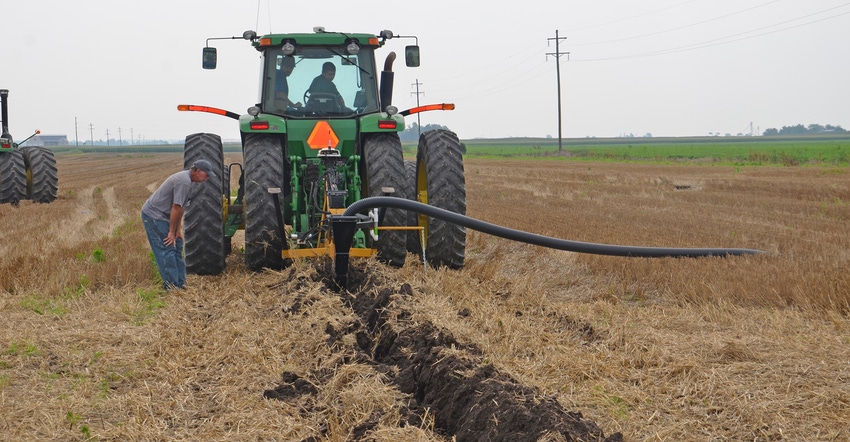
The summer land value and cash rent survey from the Purdue University Center for Commercial Agriculture reports land values at record levels. If land is priced above what you’re willing to pay, what’s your alternative for growing your farming operation?
One option is improving the land you have. If your soils aren’t well-drained or pattern-tiled, tiling might be the place to start. More than one agronomist believes wet areas will show up on yield maps this fall after near-record rainfall over much of Indiana in July. Those areas where yield is impacted usually extend well beyond where crops drowned out.
“We adopted the practice of tiling what we could afford each year, and it’s paying off,” says Tom Nugent, Elnora, Ind. He and his son Thomas farm in Daviess County.
“It’s one reason we grow wheat,” he adds. “We raise wheat in a field where we want to install pattern tile. Some of our fields have sandy soils, but that’s typically higher ground. We farm plenty of land that needs tiling to perform best, especially in a year with lots of rain like this one.”
Tiling basics
Working with Rick Applegate of Precision Farming Solutions, Birdseye, Ind., the Nugents opened their farm after wheat harvest so others could watch them install tile as part of a field day.
“We were just coming off a big rain, so we pre-ripped the first part of several lateral passes so the tile plow could go in easier and prevent slippage,” Tom explains. “Pre-ripping helps if the wheat stubble is slick. Normally, we can install tile without it.”
The Nugents use a three-point hitch tile plow from Soil-Max, an Ag Leader company based in Terre Haute, Ind. Tom McGinn with Soil-Max says it’s the smallest of three models offered. With their model, the Nugents can install 4-inch tile up to 4 feet deep.
Before the field day, the Nugents installed a long stretch of main tile using a backhoe. Then for each lateral, Thomas cut a hole in the main using a special tool and attached the lateral.
Before they make a pass, they drive it first to survey the grade, using software for tiling called Intellislope from Ag Leader.
“It won’t let the plow work if water won’t flow,” Tom says. “We’re confident we’re getting the right grade even on fields where there isn’t lots of slope.”
In their soils, the Nugents typically install 4-inch laterals about 40 feet apart. They always have the option of installing another line later if there’s a spot where that doesn’t turn out to be close enough.
What about existing clay tile? “In the lower part of the field, we just ignore them,” Tom says. “Typically, they are at a different depth anyway. Many of them still work, but they weren’t installed as pattern tile and they don’t cause issues.
“When we get to the upper side of the field where several clay tile lines were installed and are still working, we’ll hook them into the main.”
Learn more about Applegate’s company at precisionfarmingsolutions.net. Check out tile plow options from Soil-Max at soilmax.com.
About the Author(s)
You May Also Like




